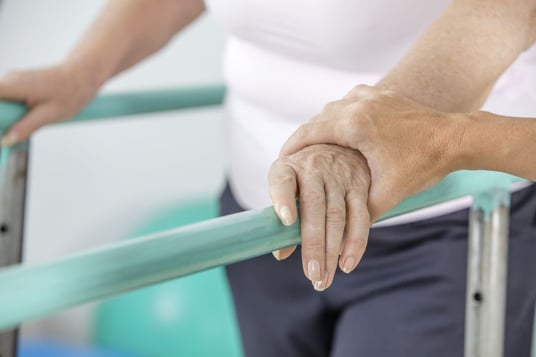
Parkinson’s disease is one of the most common neurological disorders in the U.S., largely impacting more men over the age of 60 than women and younger age groups. While the life expectancy of a person with Parkinson’s is not much different than the general population, the condition can certainly impact the quality of your life.
The key to improving life with Parkinson’s disease is prompt, ongoing treatment. Interventions like medication, physical therapy, speech therapy, and lifestyle changes can provide a better outlook for your future with the condition.
Physical therapy, in particular, can help you address the physical changes that happen as a result of Parkinson’s disease.
The Physical Effects of Parkinson’s Disease
Parkinson’s disease is a progressive neuromuscular disorder that causes nerve cell damage in the brain. The damage can lower dopamine levels and cause problems with movement and brain function.
Because Parkinson's disease causes unseen changes in the brain at the beginning stages, the condition can go unnoticed until the nerve cell damage starts to show up in physical changes. Once that happens, those with Parkinson’s may notice physical symptoms such as:
- Slowed movements
- Balance problems
- Tremors
- Muscle stiffness
- Muscle stiffness
- Loss of involuntary movements (i.e. blinking, swallowing, etc.)
You may find that regular movements like walking become slow and unsteady or that one limb starts to spasm at first. Parkinson’s can cause many physical disruptions, some that you may not notice in the beginning. That’s why physical therapy is such an important part of your treatment plan if you have the condition.
The Importance of Physical Therapy for Parkinson’s
Since Parkinson’s disease causes such an impact on the body, physical therapy can make a big difference. Even though the nerve damage caused by the disease can’t be reversed, you can improve your physical capacity and learn how to compensate for impairments.
Working with a physical therapist can help improve your balance, your gait, and your daily movements, among other skills. You can also build strength and cardiovascular capacity with aerobic and strength training.
Early on, your physical therapist can help you maintain your current functioning and favorite activities. In later stages, the therapist can help you relearn how to perform your daily activities or work around the changes in your body.
One of the main goals of physical therapy for Parkinson’s disease is to enhance your wellbeing through timely interventions and education. You should feel better as a result of the benefits of physical therapy, which include:
- Pain relief
- Better balance and coordination
- Increased mobility and control
- Fewer spasms
- Improved gait
- More energy
- Improved strength
Therapeutic interventions help you stay active and maintain your independence. Without physical therapy, you risk greater disability, more fall risk, worsening physical ability, and poorer quality of life.
Early intervention is particularly imperative as you have a vital window to address issues early on, even before you notice changes. Your physical therapy sessions are a critical part of your care.
What to Expect During Physical Therapy Sessions
Your first physical therapy session usually starts with an assessment, so your therapist can evaluate your current condition and develop an effective treatment plan. You’ll work together to set goals for what you want to accomplish. After that, your sessions focus on various physical exercises and techniques to help you optimize your abilities.
Along the way, your physical therapist assesses your progress and adjusts your program to your changing needs. They usually work in partnership with other members of your care team to maximize results.
Physical therapy for Parkinson’s disease typically includes some combination of the following:
- Stretching: increasing flexibility to prevent tightness
- Balance training: exercises that help build your sense of equilibrium and reduce fall risk
- Strength training: resistance exercise to build muscle strength
- Aerobic exercise: activities that strengthen your heart
- Movement amplitude training: exaggerated movement training to reduce hypokinesia (slowed, shortened movements)
- Gait training: specific training to help you walk better
- Reciprocal patterns: practicing rhythmic movement patterns, like swinging your arms while walking
Your physical therapist may also use hot/cold therapy, mechanical devices, ultrasound, or other techniques in your sessions. You’re also encouraged to continue practicing exercises at home to make continued progress.
With effective treatments, such as physical therapy, men and women with Parkinson’s can better manage their symptoms. They can even potentially delay or reverse the progression of the disease.
Where to Find a Good Physical Therapist for Parkinson’s disease
For the best outcome, it’s essential to find a physical therapist in your area that specializes in treating Parkinson’s. Specialists usually have more in-depth knowledge and experience to address the unique challenges of Parkinson’s.
A convenient location and insurance coverage are two other factors you may want to take into consideration when deciding on a physical therapist. You can try to find a therapist on your own, ask for recommendations from people you know, or ask your doctor for a referral.
When vetting therapists, it’s important to ask good questions and do some preliminary research to get a feel for which option might be right for you. You may also choose to tour the facility and meet the therapists in person before making your decision.
If you live in Alabama, Rehab Select is a preferred provider with an entire department dedicated to neuromuscular therapy. The facility offers comprehensive in- and outpatient treatments for Parkinson’s disease, including physical therapy, in one place. To learn more about the options Rehab Select offers, call the number at the top of the page or click here to set up a tour.




